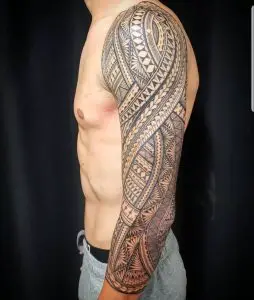Contents
What is Kirituhi Means?
Kirituhi is a term derived from the Māori language that refers to marking the skin. This particular tattoo art form is a modern take on the traditional Tā Moko style. The art of tattooing is a truly unique state of expression. Not only does each tattoo bring a personal history of the wearer, but it also tells a story of the complicated process behind its creation.
The design is typically crafted spontaneously by the artist, drawing inspiration from the wearer’s story. The Māori culture incorporates a variety of symbols and elements that hold significant meaning. These symbols can be introduced to enhance the cultural experience.
What is the origin of Kirituhi?

Tā moko refers to the traditional tattooing of the Māori people, which is deeply intertwined with their cultural customs and practices. Towards the end of the previous century, a group of Māori carvers became worried about the fading popularity of tā moko. In reaction, they took it upon themselves to revive this traditional art form. As tā moko gained popularity, it became necessary to address the issue of non-Māori claiming its motifs and formations. Te Uhi o Mataora is a group of talented tā moko artists who have come together with a common goal.
They aim to ensure that the art of tā moko is preserved and continues to thrive as a living art form. They are committed to upholding traditions while seeking to improve and develop this unique art form. (Toi Māori Aotearoa – Māori Arts New Zealand).
Kirituhi is a type of tattooing that is closely related to tā moko. The tattoo has been designed in the normal Māori fashion. However, it is possible that the artist who created it or the person who got it inked does not belong to the Māori community. Kirituhi is a special design that holds great significance in Māori culture. It represents the wearer’s story and is created using the visual language of Māori art and design. This design is believed to possess mana, a powerful force that brings authority and prestige to the wearer. ‘Kiri’ refers to the outer layer of skin, while ‘Tuhi’ describes the act of writing, drawing, recording, adorning or decorating with painting.
What is the difference between Kirituhi and Tā Moko?

Ta Moko is a traditional form of body art practiced by the indigenous Maori people of New Zealand for centuries. This art form is deeply rooted in the Maori culture and is considered a sacred practice passed down from generation to generation. Ta Moko uses chisels and ink to create intricate designs on the skin, which hold significant cultural and spiritual meanings. It is a powerful method of self-expression and a way for the Maori to connect with their ancestors and cultural heritage.
Throughout history, art has served as a symbol of status and social standing. Today, it has evolved to represent much more than that. It embodies a community’s rich culture, history, and familial ties. This art form has become a powerful means of expression and connecting with one’s roots.
Ta Moko and Kirituhi are two forms of tattoo art that convey a unique story. Each tattoo tells the story of the individual wearing it, reflecting their experiences and cultural heritage. These intricate designs are a powerful form of self-expression and hold deep meaning for those who bear them. The narrative recounts the story of one’s family (whanau), tracing their lineage (whakapapa) and highlighting their community and people (iwi). It delves into the individual’s life journey, capturing the significant moments and details that have shaped their existence.
At Moko, we follow a unique process to create personalized tattoos that truly reflect your ideas and story. Our specialists will sit down with you to understand your vision and preferences. Using markers, we design the tattoo freehand, directly onto your skin. This approach allows us to create a design that tells your story and complements your body shape.
Who can get a Kirituhi?

Recently, Moko has been categorized into two primary branches: Ta and Kirituhi. Ta Moko is a traditional tattooing practice with significant cultural and spiritual value for the Maori. It is a sacred art form reserved for individuals of Maori blood and ancestry. On the other hand, Kirituhi is a form of tattooing that is designed for people who do not have a Maori heritage. It is a way for non-Maori individuals to appreciate and embrace the beauty and symbolism of Maori art while respecting the cultural significance of Ta Moko.
Kirituhi in Today?
The art of Tā moko and Kirituhi has undergone significant changes since colonization disrupted it. Both Tā moko and the variant of Kirituhu, a traditional form of tattooing in Māori culture, have evolved and are now commonly done using a needle. However, some tā moko artists still prefer traditional methods and may alternate between the two techniques. Although the needle is known for its speed and precision, using hand tools can make the process more authentic and reminiscent of traditional methods.
This is such a unique method of tattooing that belongs to New Zealand culture, and they still follow this spiritual art method to your skin paint.





